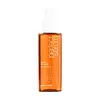What's inside
What's inside
 Key Ingredients
Key Ingredients

No key ingredients
 Benefits
Benefits

 Concerns
Concerns

 Ingredients Side-by-side
Ingredients Side-by-side

Cyclopentasiloxane
EmollientDimethiconol
EmollientC12-15 Alkyl Benzoate
AntimicrobialParfum
MaskingArgania Spinosa Kernel Oil
EmollientSimmondsia Chinensis Seed Oil
EmollientCocos Nucifera Oil
MaskingLimonene
PerfumingPrunus Armeniaca Kernel Oil
MaskingOlea Europaea Fruit Oil
MaskingSclerocarya Birrea Seed Oil
HumectantCamellia Japonica Seed Oil
EmollientCoco-Caprylate/Caprate
EmollientLinalool
PerfumingCitronellol
PerfumingCaprylic/Capric Triglyceride
MaskingGeraniol
PerfumingCapsicum Annuum Extract
MaskingBeta-Carotene
Skin ConditioningTocopherol
AntioxidantGlycolipids
Skin ConditioningCyclopentasiloxane, Dimethiconol, C12-15 Alkyl Benzoate, Parfum, Argania Spinosa Kernel Oil, Simmondsia Chinensis Seed Oil, Cocos Nucifera Oil, Limonene, Prunus Armeniaca Kernel Oil, Olea Europaea Fruit Oil, Sclerocarya Birrea Seed Oil, Camellia Japonica Seed Oil, Coco-Caprylate/Caprate, Linalool, Citronellol, Caprylic/Capric Triglyceride, Geraniol, Capsicum Annuum Extract, Beta-Carotene, Tocopherol, Glycolipids
Propylene Glycol
HumectantWater
Skin ConditioningDimethicone
EmollientPhenyl Trimethicone
Skin ConditioningGlycerin
HumectantIsododecane
EmollientDimethiconol
EmollientAmodimethicone
Phenoxyethanol
PreservativeTrideceth-5
EmulsifyingParfum
MaskingPolyacrylate Crosspolymer-6
Emulsion StabilisingTrideceth-10
CleansingMel
EmollientCaramel
Cosmetic ColorantAcetic Acid
BufferingBenzyl Alcohol
PerfumingCoumarin
PerfumingLimonene
PerfumingBenzyl Salicylate
Perfuming
 Reviews
Reviews

Ingredients Explained
These ingredients are found in both products.
Ingredients higher up in an ingredient list are typically present in a larger amount.
Dimethiconol is a silicone that resembles the popular dimethicone. Like other silicones, it is an emollient. Emollients create a thin film on skin to prevent moisture from escaping.
This ingredient helps to create a silky texture and improve spreadability. Due to its high molecular weight and thickness, it is often combined with cyclopentasiloxane.
Limonene is a fragrance that adds scent and taste to a formulation.
It's found in the peel oil of citrus fruits and other plants such as lavender and eucalyptus. The scent of limonene is generally described as "sweet citrus".
Limonene acts as an antioxidant, meaning it helps neutralize free radicals.
When exposed to air, oxidized limonene may sensitize the skin. Because of this, limonene is often avoided by people with sensitive skin.
The term 'fragrance' is not regulated in many countries. In many cases, it is up to the brand to define this term. For instance, many brands choose to label themselves as "fragrance-free" because they are not using synthetic fragrances. However, their products may still contain ingredients such as essential oils that are considered a fragrance.
Learn more about LimoneneParfum is a catch-all term for an ingredient or more that is used to give a scent to products.
Also called "fragrance", this ingredient can be a blend of hundreds of chemicals or plant oils. This means every product with "fragrance" or "parfum" in the ingredients list is a different mixture.
For instance, Habanolide is a proprietary trade name for a specific aroma chemical. When used as a fragrance ingredient in cosmetics, most aroma chemicals fall under the broad labeling category of “FRAGRANCE” or “PARFUM” according to EU and US regulations.
The term 'parfum' or 'fragrance' is not regulated in many countries. In many cases, it is up to the brand to define this term.
For instance, many brands choose to label themselves as "fragrance-free" because they are not using synthetic fragrances. However, their products may still contain ingredients such as essential oils that are considered a fragrance by INCI standards.
One example is Calendula flower extract. Calendula is an essential oil that still imparts a scent or 'fragrance'.
Depending on the blend, the ingredients in the mixture can cause allergies and sensitivities on the skin. Some ingredients that are known EU allergens include linalool and citronellol.
Parfum can also be used to mask or cover an unpleasant scent.
The bottom line is: not all fragrances/parfum/ingredients are created equally. If you are worried about fragrances, we recommend taking a closer look at an ingredient. And of course, we always recommend speaking with a professional.
Learn more about Parfum